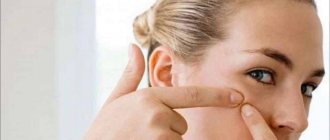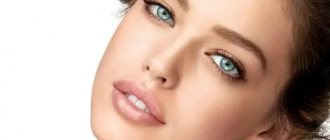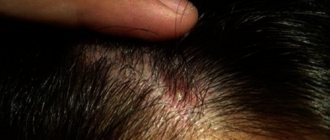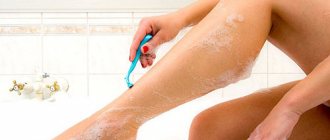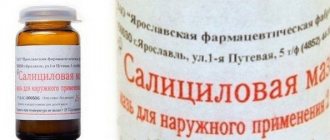Will acne go away on its own?
In most cases, acne goes away on its own in women soon after childbirth. But here it all depends on how quickly the young mother’s hormonal levels return to normal. It is also important what the condition of the skin was before pregnancy.
In most cases, skin problems disappear soon after childbirth, when the woman’s hormonal levels stabilize
Hormonal disorder
If a pimple suddenly appears and you are pregnant, then you should not panic right away. Often pregnant women have a large red pimple on their stomach. This is due to hormonal changes in the body. Since during pregnancy the level of the hormone progesterone increases, which increases the activity of the sebaceous glands. As a rule, this goes away after childbirth. But still, you should not put off visiting a doctor, since only a doctor can determine the causes of acne. The most important thing is to exclude infectious diseases during pregnancy.
There are many other causes of rashes. Pimples on the stomach also occur in men. Here are some reasons that cause acne. Nerves, improper sleep and rest patterns, disruption of the immune system, unhealthy diet (sweet, fatty, salty, smoked foods), inappropriate cosmetics, household chemicals.
Acne treatments available during pregnancy
If a pregnant woman’s rash clearly arose as an allergic reaction to some product, then simply exclude it from the diet, and the problem will disappear quite quickly. Likewise, you should stop using suspicious cosmetics.
If the problem is related specifically to the condition of the skin itself, then a woman should analyze her lifestyle and take appropriate measures: establish a drinking regime, give up unhealthy foods, bad habits, etc. Often this gives a positive result, especially if the pimples are small (reminiscent of semolina ) and are observed in small quantities.
If pimples do not go away for a long time, become larger and more painful, are accompanied by itching, and spread throughout the body, then you should definitely go to a dermatologist. He will select a drug approved for pregnancy.
If acne does not go away for a long time, and even more so spreads throughout the body and becomes painful, you should definitely consult a dermatologist.
Perhaps we are talking about an infection that definitely needs to be stopped. In addition, in some cases, a woman may need therapy to increase the body's immunity.
Even if a woman is bothered by individual pimples, she should still consult a doctor who will advise her on the optimal medication for her situation (it is unacceptable to self-medicate).
Approved drugs
Although pharmacies offer a wide range of anti-acne products, most of them are contraindicated during pregnancy. Thus, expectant mothers are prohibited from drugs (ointments, creams, gels) containing the following substances:
- salicylic acid;
- peroxides;
- retinoids (vitamin A derivatives);
- steroids;
- roaccutane, accutane;
- isotretinoin;
- alpha acids.
These substances can cause developmental defects in the fetus. As for the presence of an antibiotic in the drug, the decision is made by the attending physician. Some products act exclusively on the skin without penetrating into the systemic bloodstream.
Table: characteristics of topical medications approved (according to instructions) during pregnancy
| Name | Active substance | Features of application |
| Skinoren (cream or gel) | Azelaic acid. The substance reduces the content of fatty acids in the skin and has antimicrobial activity (against some microorganisms). Practically not absorbed into the bloodstream. | The cream is lightly rubbed into the affected areas of the skin twice a day. After a month of therapy, improvement is usually observed. The duration of treatment depends on the severity of the disease (can reach up to several months). |
| Zinerit (powder for preparing a solution) | Erythromycin and Zinc acetate dihydrate, micronized. Although Zinerit contains an antibiotic, it does not have a systemic effect on the body, since it does not penetrate into the general bloodstream. Erythromycin destroys microbes, while zinc has an astringent, antiseptic and anti-inflammatory effect, reduces the synthesis of sebum. | The prepared solution is applied to the skin twice a day in a thin layer. The course of treatment is 10–12 weeks, but improvement is observed after two weeks. |
The active ingredient of Skinoren is azelaic acid, which almost does not penetrate into the bloodstream
Cosmetic procedures
As a daily care for pregnant women with problem skin, it is worth using products with a drying effect. However, they must be safe in composition: for example, ordinary baby soap or tar soap will do (despite the not very pleasant smell, it not only removes excess fat from the skin, but also eliminates minor inflammations). By the way, you can not only wash your face with tar soap, but also wash yourself completely (it dries out rashes on the body well).
Tar soap is a natural remedy with drying and antiseptic properties.
You should forget about lotions and tonics that contain alcohol, fragrances and the previously mentioned salicylic acid.
It is important to remember that expectant mothers suffering from acne should not do mechanical facial cleansing or use scrubs (acne can spread further).
Folk remedies to help cope with acne
Before turning to medications, the expectant mother should try to improve her skin condition with the help of folk recipes:
- Rubbing the skin with infusions and decoctions of herbs with antiseptic properties, for example, chamomile, calendula (prepared at the rate of one teaspoon of dry herb per glass of water). The liquid can be frozen and used in the form of ice cubes for an additional tonic effect.
- Clay masks (white, blue, green). They will remove excess sebum and give the skin a fresher appearance. The powder is diluted with warm water until creamy and applied to the face or body for 15–20 minutes (no need to keep it longer, otherwise the skin will become very tight). Make a mask once a week (if the skin is very oily, then you can do it twice).
- Honey and cinnamon mask. The components are mixed in approximately equal volumes and applied pointwise to the affected areas. You can do this before going to bed and wash off the mask in the morning.
- Porridge of apples and horseradish. The ingredients, taken in equal volumes, are ground on a grater and applied to the face or some part of the body. After 30 minutes the paste is washed off.
- Rub with pumpkin. A small plate is cut from the vegetable, which should immediately be used to wipe the affected areas (juice should come out).
- Mumiyo with honey. 10 g of mumiyo is dissolved in 1 tablespoon of boiled water, mixed with warmed liquid honey (2 teaspoons). The mask is applied to the skin daily for half an hour for at least two weeks.
Photo gallery: traditional medicine recipes for acne treatment
There are many types of clay available in pharmacies and stores, but white, blue and green are best for fighting acne.
A mask with honey and cinnamon is applied directly to acne.
You can prepare mumiyo with honey yourself or purchase it ready-made.
You can wipe the skin with infusions or decoctions of antiseptic herbs, such as chamomile
You can simply wipe your face with a piece of pumpkin on which fresh juice has appeared.
Of course, the chosen folk remedy should not cause allergies in the pregnant woman. In addition, systematic treatment is important, not a single application.
Diet
Diet is very important when treating acne. To improve the condition of the skin, you should eat more crumbly cereals with water, fresh vegetables, fruits, herbs, and dairy products. Also, the expectant mother should receive a sufficient amount of protein and healthy fatty acids (there are many of them in red sea fish and nuts). Baked goods should be replaced with whole grain bread.
Eating certain foods will help reduce acne.
It is also necessary to avoid smoked, fried, too spicy foods and snacks. It is advisable to steam dishes.
Along with following a diet, a pregnant woman should drink a sufficient amount of clean water - at least two liters. This will reduce the concentration of the hormone progesterone in the blood, and therefore reduce the production of sebum.
Drinking enough water will help reduce the concentration of progesterone in the blood.
Is it possible to use decorative cosmetics for acne?
If the expectant mother is accustomed to constantly using decorative cosmetics, of course, there is no need to completely abandon it. If acne causes psychological discomfort to a woman, they can be carefully disguised with a light foundation or powder (a special corrector can be applied precisely). Only the product must be of high quality, have a light texture, designed specifically for oily and problem skin (for example, loose powder that does not clog pores, but absorbs excess sebum).
In addition, it is very important to take care of the cleanliness of the puff or brush for applying the product to the face (renew them more often).
Video: features of using decorative cosmetics during pregnancy
What are the causes of rashes in pregnant women?
A rash during pregnancy very often appears on a woman’s skin. There is no need to panic when you see her. It is imperative to look for the reason that caused this. In most cases, skin rashes during pregnancy are a consequence of hormonal changes. But it is important to remember that, in addition to physiological reasons, there may be others that warn of the development of very serious pathologies. In such a situation, a rash can threaten the health and life of the pregnant woman and her baby. Rashes during different periods of pregnancy indicate the presence of a separate type of problem.
- The first reason may be dermatosis, which, as a rule, is visible in the last months of pregnancy, due to hormonal changes in the body of the young mother. The main symptom of dermatosis is a rash similar to nodules and plaques, which are visible on the stomach, thighs - where there are stretch marks. After some time, the rash can merge and form large plaques that cover the buttocks, legs and even the back. A rash on the chest is also possible during pregnancy, but it disappears when the baby is born. Hormonal rash during pregnancy is not capable of harming mother and baby, and therefore is not dangerous.
- The second cause may be rubella. This is not just a rash, but a disease. Such a rash during pregnancy poses a danger to the child and mother. Rubella, which occurs in the first months, can cause cataracts, deafness, heart disease, and damage to the nervous system in the baby. Doctors recommend terminating a pregnancy if a woman has rubella in the first months of pregnancy. Symptoms of this disease: very small pale pink pimples appear all over the body, headache, nausea, and fever.
- A third cause of the rash may be measles. This rash appears during pregnancy in expectant mothers who do not have immunity to this disease. When a mother gets sick with measles in the first months of pregnancy, the baby is born weak-minded and has other pathologies. What are the symptoms of this disease? A rash similar to tubercles appears on a woman’s body. First of all, they are visible on the neck and face, and then on the torso and arms. The legs are the last to be affected. As with rubella, women who have had measles are advised to terminate their pregnancy.
- The fourth reason for the appearance of a rash can be herpes, which is an infectious disease. Most congenital diseases of the fetus occur after suffering this infection. If the expectant mother is infected with herpes for the first time, there is a 50% chance that the child may also be infected. When the disease already exists and it only worsens, infection of the baby is possible only in rare cases. It is possible to become infected with herpes through sexual intercourse, kissing, and through objects of daily use. Symptoms include: small red rashes with blisters containing clear liquid. They become red, itch very much and a strong burning sensation is felt. Time passes and ulcers form in place of the blisters. In the first trimester it is very dangerous to suffer from infection. As a result, there is a high probability that the baby will develop mental retardation, as well as problems with the cardiovascular system. If the mother got sick while pregnant in the last months and infected the baby, then in the future he may face problems such as encephalitis, hepatitis, pneumonia.
- The fifth cause is chicken pox. This disease is most dangerous in the first and last months of pregnancy. It often entails miscarriage and severe defects in the development of the baby. If the mother gets sick with smallpox in the last months, she can infect the baby, which will lead to pneumonia and hypoxia. The pathology has the following symptoms: pink spots appear on the body, with bubbles containing a clear liquid inside. After a while they become crusty and very itchy.
- Scabies takes sixth place in the ranking. With this disease, blisters and bumps form on the skin. Most often they are between the fingers and toes. The rash is very itchy, but does not pose a danger to either the mother or the unborn child.
- The seventh and final cause of rash is allergies. It is most common among pregnant women. In this position, the mother’s body can react in a special way to various substances, including allergens. With allergies, the rash takes the form of blisters and large red spots.
READ ALSO: Scabies: photos, symptoms
We also recommend reading: Implantation retraction
Preventive measures
The following simple measures will help reduce the likelihood of acne at different stages of pregnancy:
- Cleanse your face daily, removing impurities and excess sebum. To prevent acne, you can make clay masks once a week.
- Walk a lot in the fresh air away from polluted streets. After a walk, always wash your face.
- Drink enough water and follow the diet indicated earlier.
- Change bed linen (especially pillowcases) and towels more often.
- Do not touch your face with your hands unless necessary. A single pimple that appears does not need to be squeezed out - this can increase inflammation and lead to the spread of infection.
- Choose clothes made from natural fabrics.
- Try to be less nervous and learn available methods of relaxation.
A pregnant woman should take walks in the fresh air more often (in nature, in parks, squares) - it has a beneficial effect on the condition of the skin
What causes acne on the genitals?
In the intimate area, the skin is especially delicate. Any damage to the epidermis can lead to inflammation and rash. A pimple in an intimate place causes significant inconvenience to a woman. The tumor hurts, itches, and breaks out. The situation is complicated by constant contact with underwear. If a pimple appears on an intimate place after shaving, there is no need to worry.
Pimples on the labia during pregnancy are a dangerous symptom that warns of a serious pathology. Rashes indicate the activity of viruses or sexually transmitted infections. In this case, the pregnant woman experiences additional symptoms:
- purulent vaginal discharge;
- pain in the lower abdomen;
- weakness;
- fast fatiguability;
- discomfort in the intimate area;
- itching and burning in the labia area;
- increase in body temperature to 37°C.
A pimple on an intimate place brings significant inconvenience to a pregnant woman.
A pimple on an intimate place can be a sign of herpes type 2. The disease is dangerous and requires therapy. Infection with herpes occurs both before pregnancy and during pregnancy. The pathology is introduced into the body through sexual contact with a partner who is a carrier of the virus. For a long time, herpes does not manifest itself in any way.
If a woman infected with the virus has not previously had acne in the labia area, she may develop acne during pregnancy. This is not dangerous for the fetus, since the placenta is a reliable protection. A child can become infected with such acne during natural childbirth, so women with type 2 herpes undergo a cesarean section.
Neoplasms of this nature are removed surgically. In some cases, papillomas and condylomas are a temporary phenomenon. Women often confuse these growths with ordinary acne and wait until the skin recovers on its own. This tactic of behavior is fundamentally wrong. The earlier therapy is started, the less likely it is that the fetus will become infected during natural childbirth.
Dermatosis
A red rash during pregnancy is often the result of dermatosis, a disease whose causes have not yet been fully established. Such rashes appear in the area of stretch marks that appear on the abdomen; Most often, dermatosis occurs in the third trimester; in the early stages of pregnancy, a rash of this type is rare. Most often, primiparous women suffer from this disease.
Dermatosis looks like small nodules and red plaques; their diameter rarely exceeds 1-2 millimeters. With a long course of the disease, the nodules merge together, forming large areas of skin damage. A few days after it appears, the rash may spread, affecting the skin of the chest, legs, buttocks and back.
Usually, within 1-2 weeks after birth, the rash disappears without a trace, without having a serious impact on the health of the mother or fetus. If redness and itching cause severe discomfort, you can consult a doctor - for dermatosis, local hormonal and non-hormonal agents are most often used.
READ ALSO: Rash like mosquito bites - photos, causes in adults, how to treat
